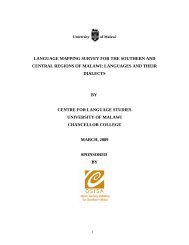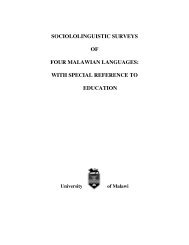languages and area spoken for chitipa - Centre for Language Studies
languages and area spoken for chitipa - Centre for Language Studies
languages and area spoken for chitipa - Centre for Language Studies
You also want an ePaper? Increase the reach of your titles
YUMPU automatically turns print PDFs into web optimized ePapers that Google loves.
Table : <strong>Language</strong>s chosen as subjects <strong>and</strong> media of instruction by district.<br />
District<br />
<strong>Language</strong> to be used as<br />
Medium of instruction<br />
<strong>Language</strong> to be taught as<br />
subject<br />
Chitipa<br />
Chilambya <strong>and</strong> Citumbuka Chilambya <strong>and</strong> Citumbuka<br />
(Nthalire <strong>and</strong> Wenya)<br />
Karonga<br />
Kyangonde <strong>and</strong> Citumbuka Kyangonde <strong>and</strong> Citumbuka<br />
(Mwirang’ombe <strong>and</strong><br />
Wasambo)<br />
Rumphi Citumbuka Citumbuka<br />
Mzimba Citumbuka Citumbuka<br />
Nkhatabay<br />
Chitonga <strong>and</strong> Citumbuka<br />
(Sisya)<br />
Chitonga <strong>and</strong> Citumbuka<br />
The data in the above table shows that <strong>languages</strong> that predominant in each district are<br />
chosen as media of instruction <strong>and</strong> subjects. In Chitipa, Chilambya is the most dominant<br />
language in many of the <strong>area</strong>s while Citumbuka is dominant in Nthalire <strong>and</strong> Wenya. In<br />
Karonga, Kyangonde <strong>and</strong> Citumbuka are chosen as the <strong>languages</strong> to be used as medium<br />
of instruction <strong>and</strong> taught as subjects. In Karonga <strong>and</strong> Rumphi respondents chose<br />
Citumbuka because it is the main language. However, in Mzimba many respondents<br />
would have loved to have Chingoni taught in the schools as means of reviving it.<br />
Nkhatabay, which is a predominantly Tonga speaking district, chose Chitonga <strong>and</strong><br />
Citumbuka as the <strong>languages</strong> to be used in schools. Citumbuka is particularly<br />
recommended <strong>for</strong> <strong>area</strong>s bordering Rumphi in the North in Usisya <strong>and</strong> <strong>area</strong>s bordering<br />
Mzimba in the west. What should be noted, however, is that although major <strong>languages</strong><br />
were chosen to be used in schools in most districts speakers of minor <strong>languages</strong> preferred<br />
to use their <strong>languages</strong> because that is the language their children underst<strong>and</strong> <strong>and</strong> as a way<br />
of promoting them.<br />
6.0 Materials written in local <strong>languages</strong><br />
This study also sought to establish whether or not the respondents knew of any materials<br />
written in any of the <strong>languages</strong> <strong>spoken</strong> in the region. Of the 751 total respondents, 611<br />
representing 81.4 % indicated that they had some knowledge of materials written in local<br />
<strong>languages</strong>. However, when pressed further to state some more in<strong>for</strong>mation about these<br />
materials such as author, publisher, date of publication <strong>and</strong> year of publication, many<br />
respondents could not remember such in<strong>for</strong>mation. In view of this, it is obviously<br />
necessary that a follow up study should be undertaken to verify <strong>and</strong> establish the<br />
existence <strong>and</strong> whereabouts of these materials. A summary of materials <strong>and</strong> local<br />
<strong>languages</strong> in which they are written is shown in table .. in appendix 2<br />
Results however show that Citumbuka has a lot of written materials. Apart from that,<br />
these results also reveal the fact that most of the <strong>languages</strong> in the Northern Region such<br />
as Chilambiya, Chindali, Kyangonde/Chinkhonde, Chitonga <strong>and</strong> others have a number of<br />
25





